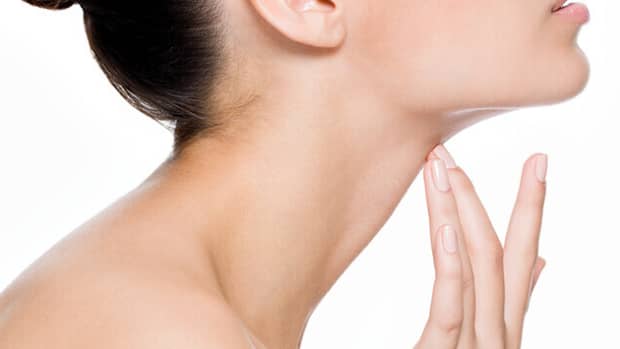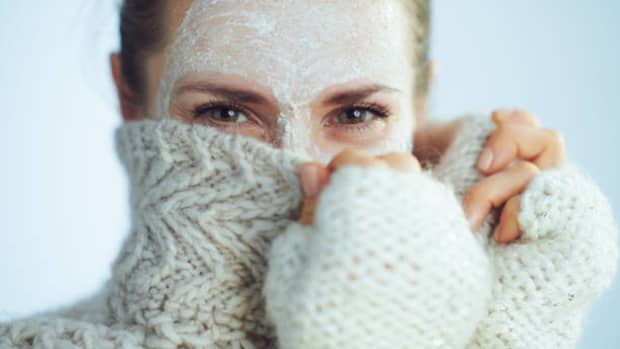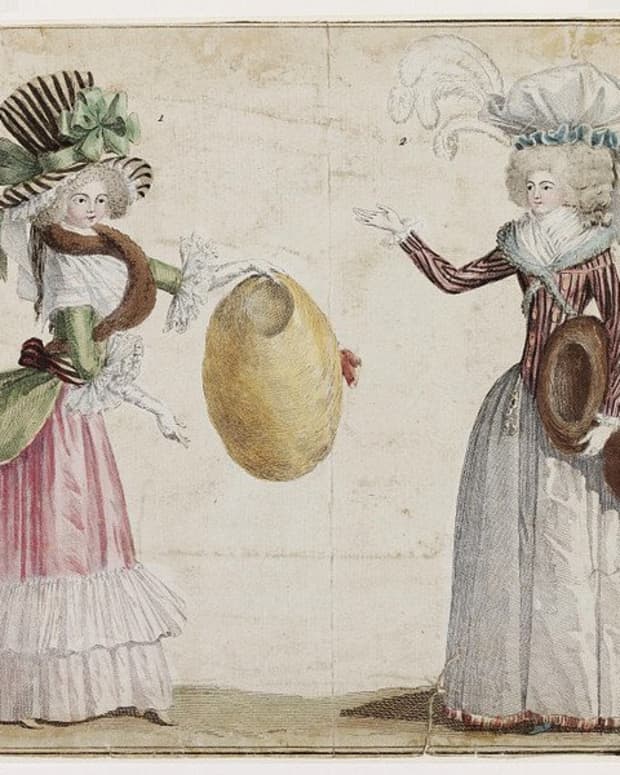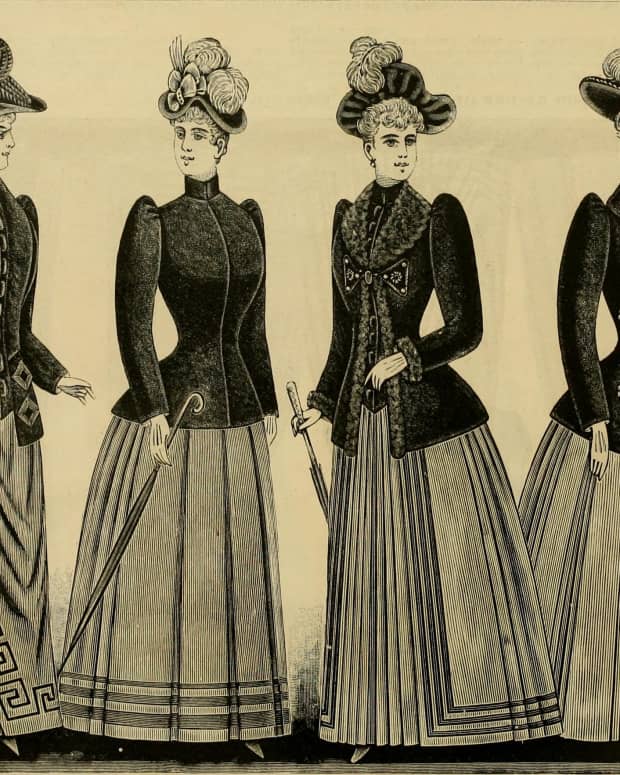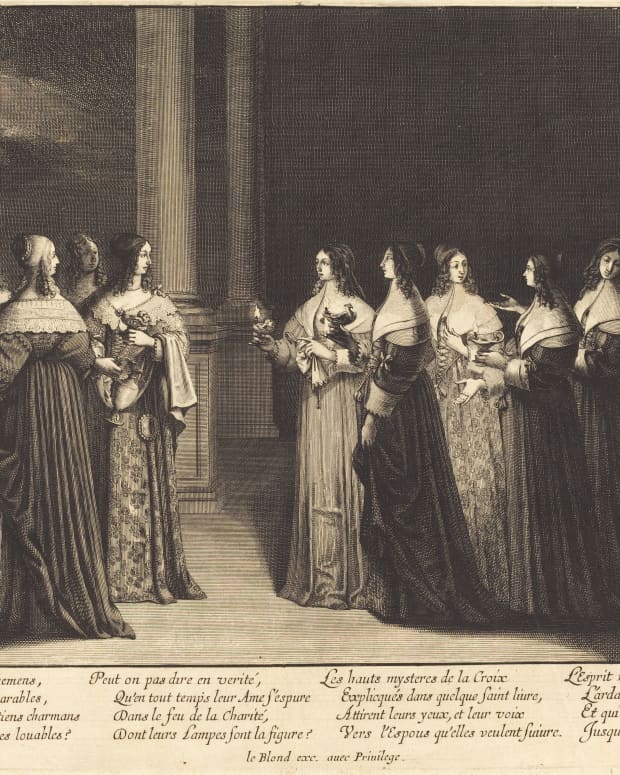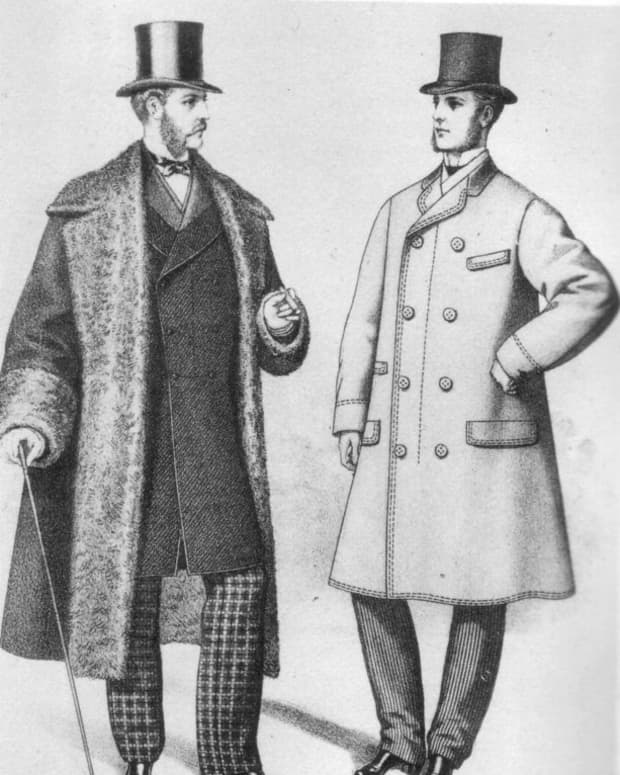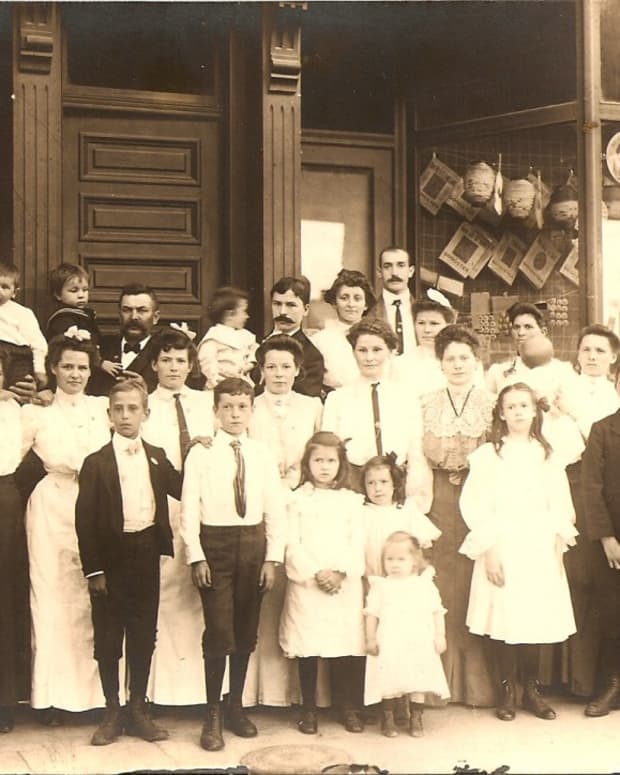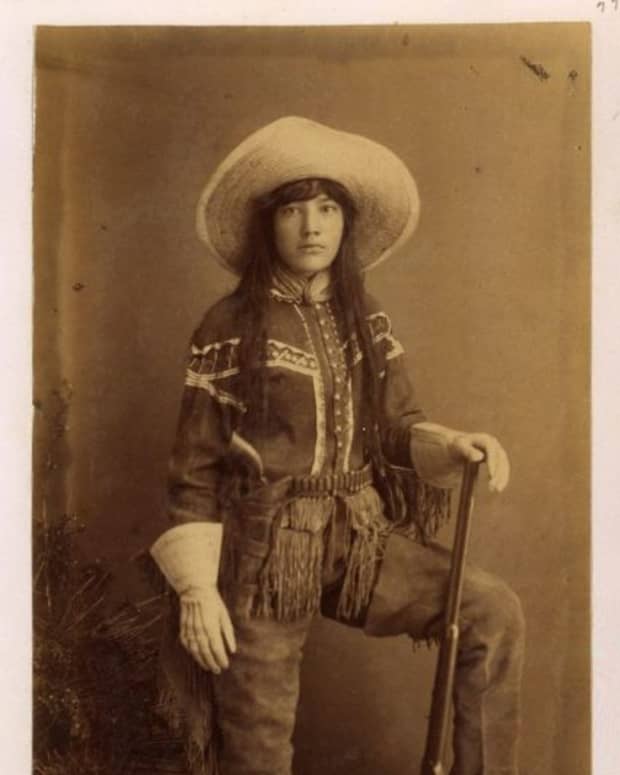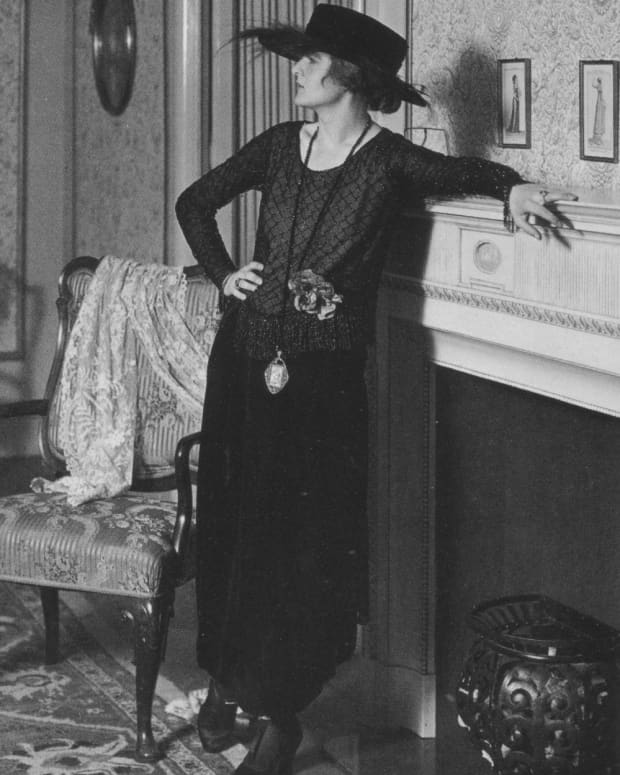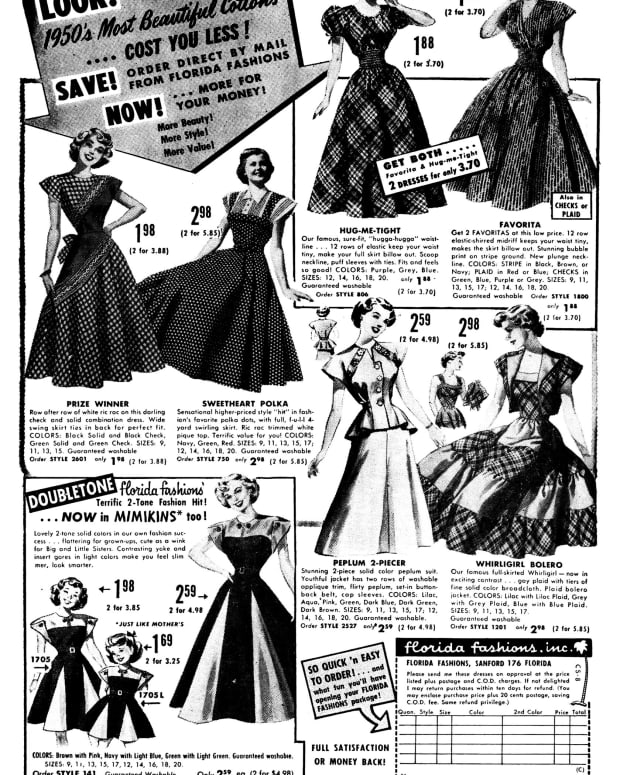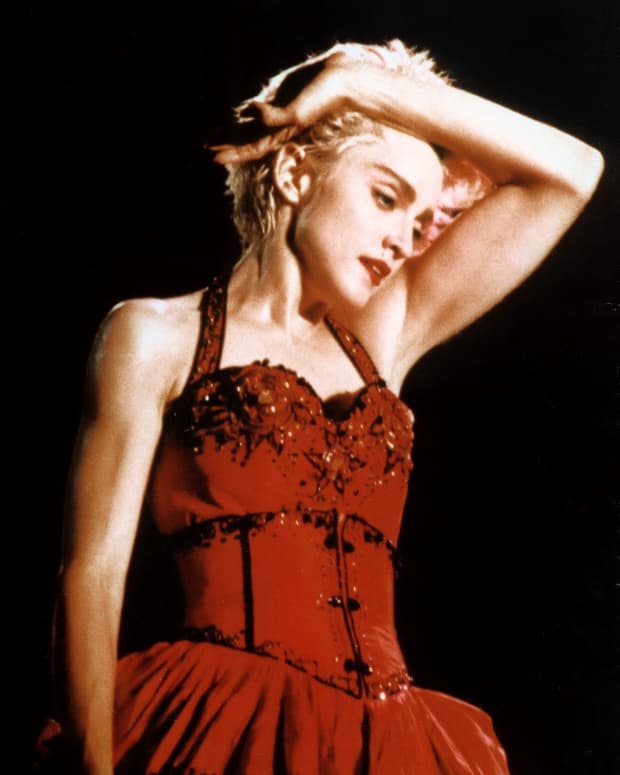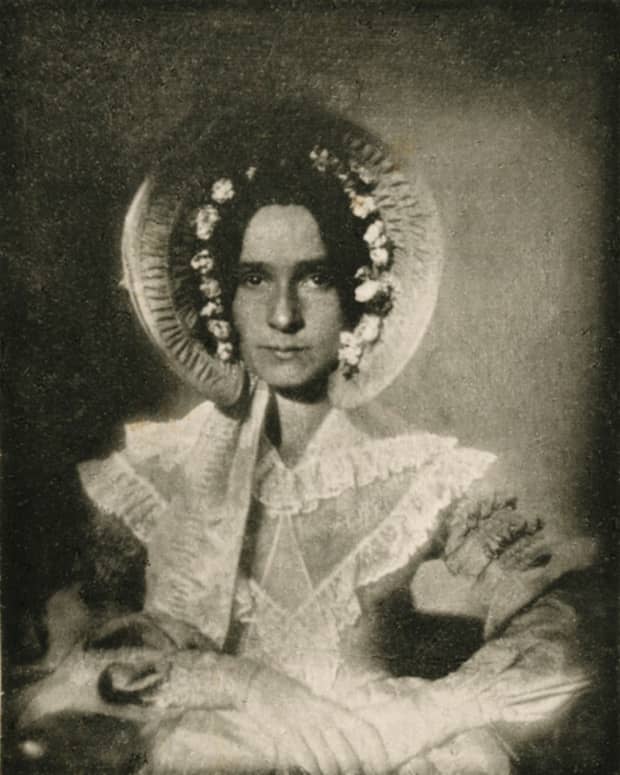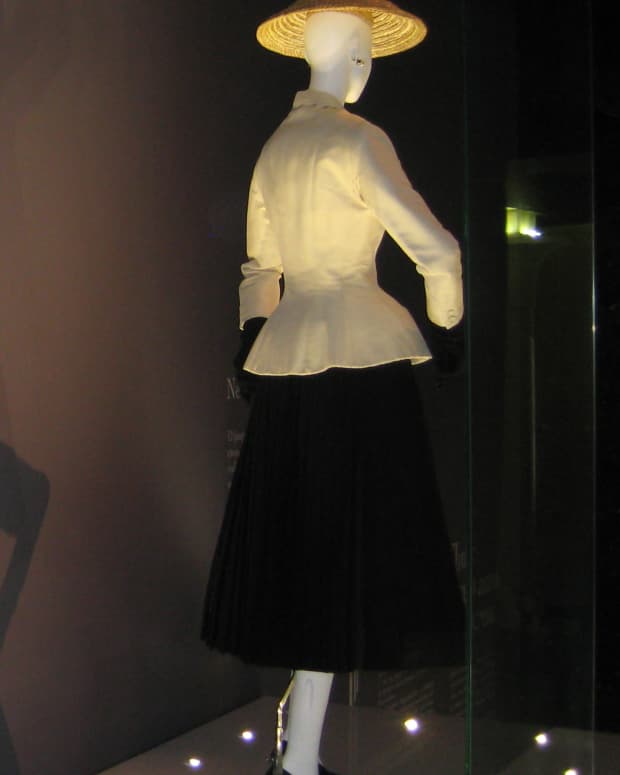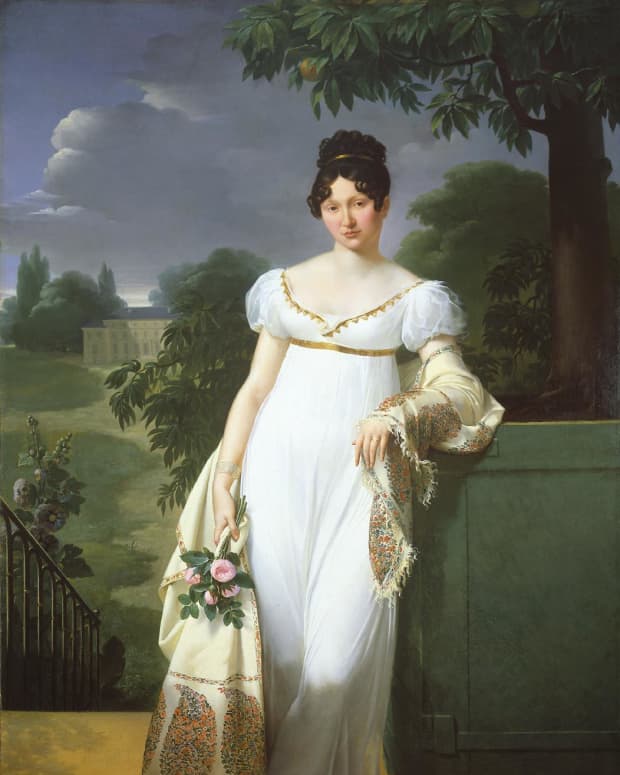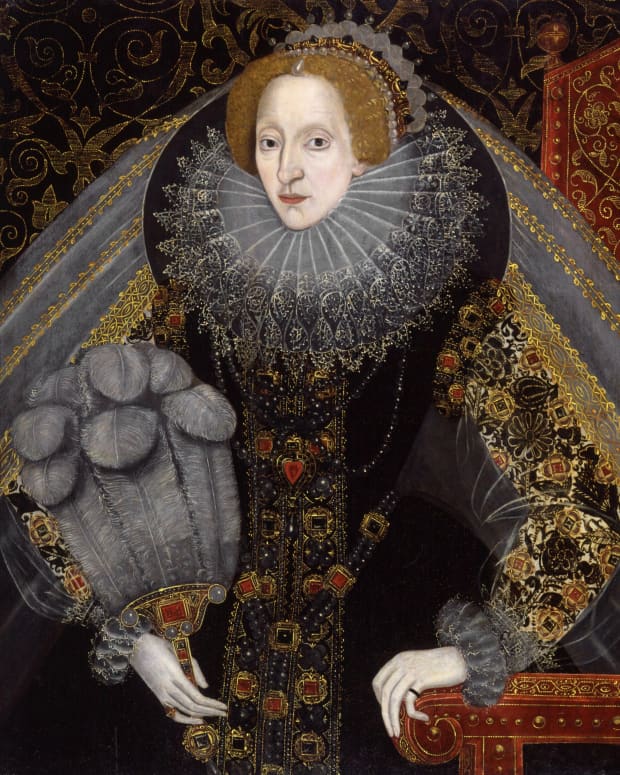The Bustle Era: Women's Fashions of the 1870s and 1880s
Dolores's interest in fashion history dates from her teenage years when vintage apparel was widely available in thrift stores.
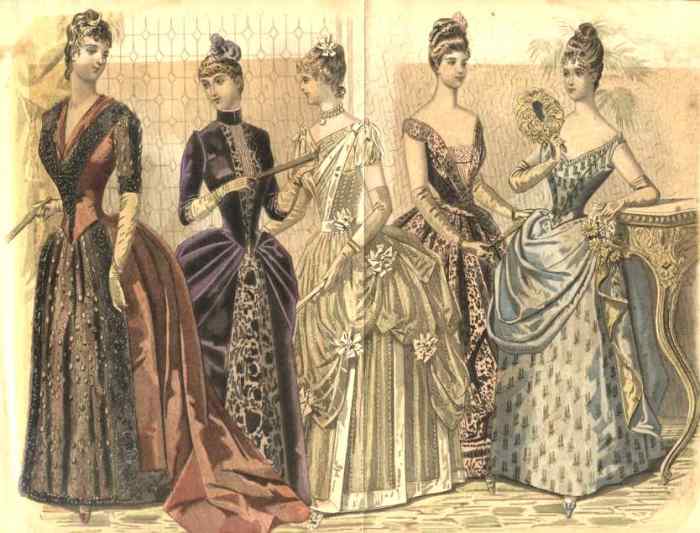
Fashion Plate circa 1888 from Peterson's Magazine. First and second figures wear polonaise style.
downloaded by user Borwaeddie on wikimedia commons; PD
Women's clothing of the 1870s and 1880s was heavily trimmed, ornamental, and draped. The hourglass figure of the mid-19th century gave way to a longer, slimmer silhouette with narrow skirts. Emphasis on the back of the skirt grew from fabric gathered at the rear to the exaggerated, shelf-like bustle of the mid 1880s.
Background
During the 1870s and '80s the Industrial Revolution produced a concept of conspicuous consumption. Capitalism generated a new type of elite and class consciousness. While once status was based on royalty, nobility, and land ownership, a new social elite grew out of industry.
The Victorian concept of morality based on financial success tied self identity with consumption. As mass production increased the availability of products the producers of those goods needed new customers. Advertising, fashion magazines, and department store marketing enticed a materialistic culture to desire novelty, luxury, and ornamentation.
Architecture and interior design looked to historic periods for inspiration. Furniture and buildings reflected and mixed Gothic, Renaissance, Rococo, and Louis XVI styles.
Department stores lured shoppers with lavish displays, creating the concept of shopping as entertainment. Self identity merged with the consumption of increasingly ostentatious products. Combine these new social norms with the ideal of feminine status displayed by immobility and you have the basis for fashions of the Late Victorian era. Elite women did not work. A stiff, rigid posture underscored the lack of movement that separated the upper class from the working class.
Fashions of the period are easily gleaned from photographs, advertising, fashion magazines, and fashion plates. While portraiture and painting does not always reflect styles of the day, many artists depicted what women actually wore. The painter James Tissot depicted women in contemporary costume. August Renoir's paintings reflect the clothing worn by the middle and working class.
Dress of 1870-1878
- Two-piece outfits featured a bodice and skirt. A bodice was a stiff, fitted jacket like garment usually supported with whalebone or steel. The bodice of this period featured a basque which extended below the waist and could reach the knees at the back.(See picture below)
- Tight-fitting sleeves reached 3/4 length or to the wrist. Coat sleeves were fitted and ended in deep cuffs.
- Sleeves were set higher that than earlier when drop shoulders restricted arm movement.
- Skirts usually matched the bodice. Horizontal draping and overskirts required copious amounts of fabric. Overskirts were gathered at the back, supported by a bustle that was attached to a crinoline.
- Many women kept two bodices for every skirt—one for day wear and one for evening. Evening bodices were often off the shoulder with very short or elbow-length sleeves edged with ruffles. Evening bodices also featured more decorative embellishments than for day wear.
- Necklines came in V neck, rounded, or squared styles. More open necklines could be filled with a lace frill or chemisette. Low-neck bodices featured high necks at the back.

Summer dress circa 1870-74 cotton tabby with horizontal draping on the front of the skirt
Patricia Harris Gallery of Textiles and Costume, Royal Ontario Museum, wikimedia commons; user Dader
1878-1883
The bustle grew small with the introduction of the cuirass. Bodices featured a point below the waist in front and were fitted smoothly over the hips. The skirt grow a long, heavy train. Embellishments appeared low and at the back of the skirt. Narrow skirts made walking difficult, resulting in small, mincing steps. Some skirts featured horizontal draping created with hidden strings and hooks.

Princess line dress with very narrow skirt and parasol circa 1879
wikimedia commons' by artrenewal.org; public domain
1883-1890
- The bustle came back in a big way. A large, shelf-like protrusion at the rear was more exaggerated than the softly draped bustle of the 1870s. Trains mostly disappeared and hemlines ended a few inches above the floor.
- Wrist-length sleeves remained tight. Small puffs developed at the top of the sleeve, a precursor to the balloon like leg-of-mutton sleeves of the 1890s.
- The bodice remained closely fitted with short basques or polonaise styles. This was a longer coat like dress worn open over an underskirt.
- Long, belted blouses hung to the hip.
- High collars worn closely fitted were supported with whale bone and came attached to bodices, dresses, or jackets.
Historical Influences
Polonaise cut bodices and gowns recalled women's fashions of the 1700s. The bodice portion extended below the waistline and hung like a long, open robe or coat. Polonaise could appear as a gown that was cut away in the front, then drawn back over the hips. Some polonaise styles appeared quite gaudy with the under and over dress made of contrasting fabrics, or one printed and one plain fabric. Trim made of one portion decorated the other and vice versa. Some critics complained of the patchwork look and odd arrangement of trim.
Dolly Varden was a polonaise style named after a character in a Charles Dickens novel. Similar to 18th century styles, bright colors and floral patterns came in cotton, chintz, or muslin.
A princess line dress recalls medieval gowns. Full length pieces of fabric are joined to create a straight line without a defined waist. Form is created with darts. A princess dress worn a la polonaise with an overdress draped back towards the rear. Some featured a pattern or different colored front panel.

Princess line dress with train in lightweight cambric (closely woven white linen or cotton)
Fashion Museum of Antwerp Museum of Modern Art; wikimedia commons CCA
Tea Gown
Artists of the Aesthetic Movement often designed the clothing worn by their models. The movement, originating in the 1840s saw the mass production brought by the Industrial Revolution as dehumanizing and sought a simpler beauty based on craft and historic styles. The forms and designs introduced by these Pre-Raphaelite artists began to influence women's clothing. The tea gown, born of these softer designs was worn by women at home when they received friends for tea.
Read More From Bellatory
Tea gowns were worn without corsets. More comfortable than the standard day wear, tea gowns were loose and often featured loose flowing sleeves.They could be practical or decorated with lace and flounces for a soft, romantic look.

Tea gown - Whistler's Symphony in Flesh Color and Pink
Frick Collection; downloaded by user Screwing; wikimedia commons; PD
Sportswear
Women increasingly engaged in tennis, croquet, boating, riding, and golf. Tennis costumes were produced in soft knit fabrics called jersey, named after the famous actress, Lillie Langtry, the Jersey Lily (she was born on the British island of Jersey).
Though women did not engage in actual swimming, bathing was a popular summer activity. Bathing costumes consisted of bloomers worn with an overdress, black stockings, and bathing shoes. By the 1880s, bloomers shortened to the knee. By 1885, some bathing costumes were sleeveless.

Bathing costumes in 1882 From a Strawbridge and Clothier department store mail order catalog
wikimedia commons; downloaded by FAE; CCa
Hair and Hats
In the 1870s, hair was worn parted at the center and pulled to the back of the head with some curls framing the face. Large braids or long curls hung down the back of the head.
As the silhouette slenderized, hair was worn closer to the head arranged in a tight bun with curls around the edges and at the nape of the neck.
When large configurations of curls hung at the back of the head, hats tilted up or set on front of the head. Some hats set back resting on a chignon.
The back of women's hair often mirrored the back of the skirt. The eruption of large, festooned bustles led women to wear scalpettes or frizzettes which were false hair pieces.
Hats of the period were heavily festooned with ruffles, lace, feathers, and flowers. The early 1880s saw beaded edging on the hat brim. Between 1884 and 1888, the Postilion hat featured a high, flat crown with a narrow brim that turned up on one side or at the back.
Some brims rose to an arched point in front in the late 1880s.
Hats were made of plush, felt, or velvet. Straw hats were popular in summer.
Footwear
While lower heels predominated mid century, heels rose in the 1870s. Shoes and boots sported high heels and pointed toes. Boots reached lower to mid calf. Winter boots were trimmed in fur. Women wore white boots in warmer weather.
Evening shoes or slippers made of white or cream colored leather or satin were sometimes decorated with ribbons or faux flowers.
Stockings matched one's outfit or shoes and could be embellished with embroidery or striped. In the 1870s white silk stocking patterned with tiny designs were popular. Black stockings predominated in the 1880s.

Fan constructed of bone, cotton lace, mother of pearl and metal 1880s
LA Museum of Art; downloaded by FAE; PD
Accessories and Jewlry
- Gloves were an important part of a woman's outfit. Long, elbow length or above the elbow length were worn for evening with short sleeves. Short wrist length gloves appeared with long sleeves.
- Folding fans were a popular accessory of the era. Pretty lace or painted pictures decorated the fan that was supported on tortoise shell, wood, or ivory sticks.
- Parasols protected women's skin from the sun. Many featured ornate handles and long points at the ends. Trimming ran around the edge of the fabric.
- The elite wore brooches, hair combs, necklaces, rings, and bracelets adorned with diamonds, pearls, garnets,rubies, and emeralds set in gold. Less wealthy people wore pearls or garnets as well a faux gems.
- Black jewelry made of jet or black onyx was popular and could be worn during mourning periods when garments were restricted to black following the death of a loved one.
- Tortoise shell appeared as hair combs and was used to create pique in which the shell was inlaid with precious metal.
- The discovery of vast amounts of silver led to the mass marketing of silver jewelry, affordable for the middle class.
- Cameos, those lovely pieces of carved shell or coral, were abundant and worn by the upper and middle class.
Undergarments
Many layers of undergarments made getting dressed quite an ordeal. However, each piece was attractive in cut and fabric with tiny embellishments.
Corsets made of heavy, pieced and starched cambric offered support with bands made of whale baleen or steel . Corsets covered and lifted the lower bust. Tiny waists were emphasized by a flare at the hips. These uncomfortable undergarments accentuated an ideal figure and were viewed as an essential support for women. Dress reformers and health professionals reviled the corset and dangerous as well as unnatural. Exaggerated claims blamed this ubiquitous undergarment for miscarriage, cancer, epilepsy, and nervous hysteria.
Corset covers hid the stiff lines of the corset.
An underbodice was like a sheer, pretty undershirt that ended at the waist. Worn for warmth or modesty under a sheer dress or bodice, underbodices featured trim at the top which could be seen when wearing low necked bodices.
A chemisette was like a dickey. The sheer, lacy, delicate garment worn with a low necked bodice could change the look of an outfit. In those days women did not own as many garments as they do today so enjoyed slight changes to add variety to their wardrobes.
Drawers tied at the waist with legs ending below the knee. Edging at the bottom was simple, featuring lace, embroidery, or ribbons. Like the drawers of the past, drawers of the 1870s and 80s had an open crotch.
A combination was a shoulder to knee garment with legs worn under a dress instead of a chemise and drawers. Made of wool for winter, cotton or linen in summer, this garment proved less bulky than wearing several undergarments.
The bustle provided support for dresses and skirts that exaggerated the rear. Horizontal ruffles of stiffened material and horsehair pads tied around the waist. Bustles also appeared as long, spiraling coils worn horizontally, hoops sewn into cambric, or braided and netted wire. The Langtry bustle could collapse for ease when sitting.
Outerwear
Capes and cloaks of the mid 19th century gave way to coats and jackets. Jackets worn tight across the upper back could have a loose or tight front and ended just below the waist.
Coats worn knee length or longer were designed and cut to accommodate bustled skirts. Sleeves featured wide, turned back cuffs.
The pelisse was a robe like garment that fell 3/4 length or reached the floor. Often high waisted, the pelisse was trimmed with fur.
An ulster coat was a log, belted coat with a removable shoulder cape and hood.
Chesterfields were slender, tailored coasts similar to menswear. They featured small, velvet collars.
© 2017 Dolores Monet
Comments
Dolores Monet (author) from East Coast, United States on September 09, 2019:
Hi Katie - I am glad that you enjoyed my article. I have written articles on the history of fashion and often include historical perspectives on how clothing reflects the political and social mores of an era. But mostly it's about the clothes. You can see some of my other articles in the sidebar at the top right.
Katie Vandyck on September 07, 2019:
The first part of your article that describes the change in social hierarchies and the consequent concentration on identity as being defined by you HAVE rather than how well born you are, is as well expressed a description of how the Industrial Revolution brought about the curse of over-consumption as I've ever seen. Brilliant. Thank you Dolores. The rest of the article is very enjoyable too, and so helpful. Such good work. I found the part about Tissot and his realistic depiction of late 19th century women's clothing particularly useful. You written any other articles, or books? With best wishes, Katie
Dolores Monet (author) from East Coast, United States on June 30, 2017:
Peggy - love the old looks too but they were so uncomfortable. Of course the heavy clothing and fancy bustles were used more by the upper class. Women who did any kind of work had to wear clothing they could move in.
Peggy Woods from Houston, Texas on June 29, 2017:
I love viewing paintings of that era but cannot imagine having to dress that way. It is interesting how fashions, architecture and interior design all seemed to blend.
You have assembled great photos to illustrate the fashions of that era. I'm happy that I do not have to worry about buying a collapsible Langtry bustle. Ha!
Dolores Monet (author) from East Coast, United States on May 05, 2017:
Hi Sweetie Pie - I love the old outfits too. They are so beautiful even when they seem ridiculous like the giant bustles. Thanks!
SweetiePie from Southern California, USA on May 04, 2017:
I love looking at art and photos of fashion from that time, but would not want to wear it. Funny how the large derrière seems to be making a comeback, but now more via fitness and squats.
Dolores Monet (author) from East Coast, United States on May 02, 2017:
Hi Bill - well that's good because you'd probably look a bit silly in a bustle!
Dolores Monet (author) from East Coast, United States on May 01, 2017:
Hi Blond Logic - I am so glad to live in an era when you can pretty much wear what you want. Back then the servants and working people dressed more comfortably so they could move around. Corsets must have been like torture. Lead was used less in the 1870s and 80s as makeup was considered vulgar and only hints of color were achieved through the use of lip salves, many of which were homemade. Lead was used to whiten the face in the 1700s and earlier.
Mary Wickison from Brazil on April 25, 2017:
They are so elegant and elaborate.
With all that fabric and cinched in waist, I can see why fainting occurred more then than now.
Plus makeup with lead...
I wonder what history will say about the fashions of today.
Fabulous images and information.
Ann Carr from SW England on April 25, 2017:
What a charming hub, Dolores! I love the way you link in the historical and social details as well as the other fashions of hairstyles, shoes etc. It makes the whole thing so interesting.
How on earth did they ever sit down in those bustles? Someone else could sit on the one in that c1885 picture!
Fashion styles are always so intriguing and you always do them proud.
Ann
Dolores Monet (author) from East Coast, United States on April 25, 2017:
Hi FlourishAnyway - I used to have a black lace boned bodice from the late 1880s or early 90s. I was so skinny then that it actually fit. Sadly, it wandered off as do the things we have in our youth. Wish I still had it. Those boots sound awesome. Thanks!
Dolores Monet (author) from East Coast, United States on April 25, 2017:
Hi simplehappylife - me neither. They could not bend in those corsets. But at home they could wear a tea gown so they could actually move. Fake hair pieces have been around for ages! I love the boots too. Now those I could see wearing! Glad you enjoyed!
simplehappylife on April 24, 2017:
1. I'm so glad current customs don't require us to wear as many layers as these poor women had to wear. Imagine the Summers! LOL
2. I had no idea that fake hair pieces have been used for this long (other than wigs, of course). I truly thought that was a fad of our modern times.
3. I love those black boots. So pretty :)
Thanks for the fun read!
FlourishAnyway from USA on April 24, 2017:
I love the Victorian style of clothing. Not so much on all the hairstyles and I'd sure hate to wear one of those bathing suits, but this was a real treat of an article. I have a pair of antique lace-up black boots from the era and have often wished I had a lovely dress from this era to display in my home.




